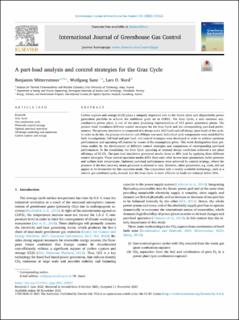| dc.description.abstract | Carbon capture and storage (CCS) plays a uniquely important role in the future clean and dispatchable power generation portfolio to achieve the ambitious goals set at COP21. The Graz Cycle, a zero emission oxy-combustion power plant, is one of the most promising representatives of CCS power generation plants. The present work introduces different control strategies for the Graz Cycle and the corresponding part-load performances. The process simulation is composed of a design-point (full-load) and off-design (part-load) of the cycle. In order to do this, the process simulation tool IPSEpro was used. Individual cycle components were modelled for both investigations, full load and part load, and control strategies were developed in order to achieve optimum performances and operating efficiencies by means of the assumptions given. This work distinguishes from previous studies by the development of different control strategies and comparison of corresponding part-load performances. In the simulation, the Graz Cycle operating at nominal design conditions achieved a net plant efficiency of 53.1%. The part-load simulation generated results down to 40% load by applying three different control strategies. These control operation modes differ from each other in two basic parameters, boiler pressure and turbine inlet temperature. Optimum part-load performances were achieved by control strategy, where the pressure of the heat recovery steam generator is allowed to vary. However, other parameters, e.g. costs, did not appear to be favourable for this operation mode. The comparison with a readily available technology, such as a natural gas combined cycle, showed that the Graz Cycle is more efficient as loads are reduced below 50%. | en_US |

